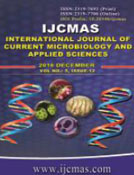


 National Academy of Agricultural Sciences (NAAS)
National Academy of Agricultural Sciences (NAAS)

|
PRINT ISSN : 2319-7692
Online ISSN : 2319-7706 Issues : 12 per year Publisher : Excellent Publishers Email : editorijcmas@gmail.com / submit@ijcmas.com Editor-in-chief: Dr.M.Prakash Index Copernicus ICV 2018: 95.39 NAAS RATING 2020: 5.38 |
The present study was carried out to determine the prevalence of Staphylococcus species in clinical samples and to find out the trend of susceptibility to antibiotics in a rural setting. Standard microbiological and biochemical methods were used to screen 503 clinical specimens comprising of sputum, pus, urine and blood for Staphylococcus species. One thirty nine isolates were obtained from these samples. Of the 64 positive isolates from pus, 19 were Methicillin sensitive Coagulase negative Staphylococcus species (MS-CoNS), 17 Methicillin resistant Coagulase negative Staphylococcus species (MR-CoNS), 24 Methicillin sensitive Staphylococcus aureus (MSSA) and 4 Methicillin resistant Staphylococcus aureus (MRSA). Out of the 30 isolates from urine 12 MS-CoNS, 10 MR-CoNS, 6 MSSA and 2 were MRSA. Blood grew 17 MS-CoNS, 12 MR-CoNS ,6 MSSA and no MRSA. The 10 sputum positive samples had 9 MSSA and 1 MRSA. Antibiotic susceptibility testing was done for all the positive isolates. Linezolid has been found to be the most sensitive to all the four categories followed by Gentamicin. For MSSA, Clindamycin and Erythromycin has been found to be equally sensitive (53%). Penicillin is the least effective drug for all the 4 categories. All the MRSA were sensitive to Vancomycin. Also it was noted that there was a reduction in the prevalence of MRSA (5.03%) from this area.
 |
 |
 |
 |
 |